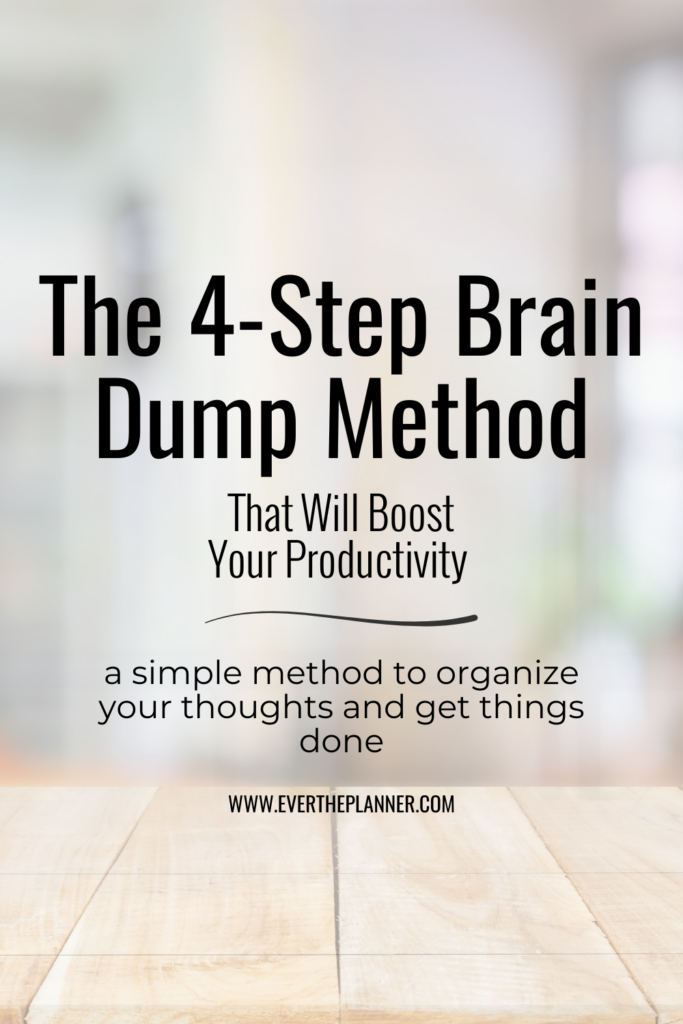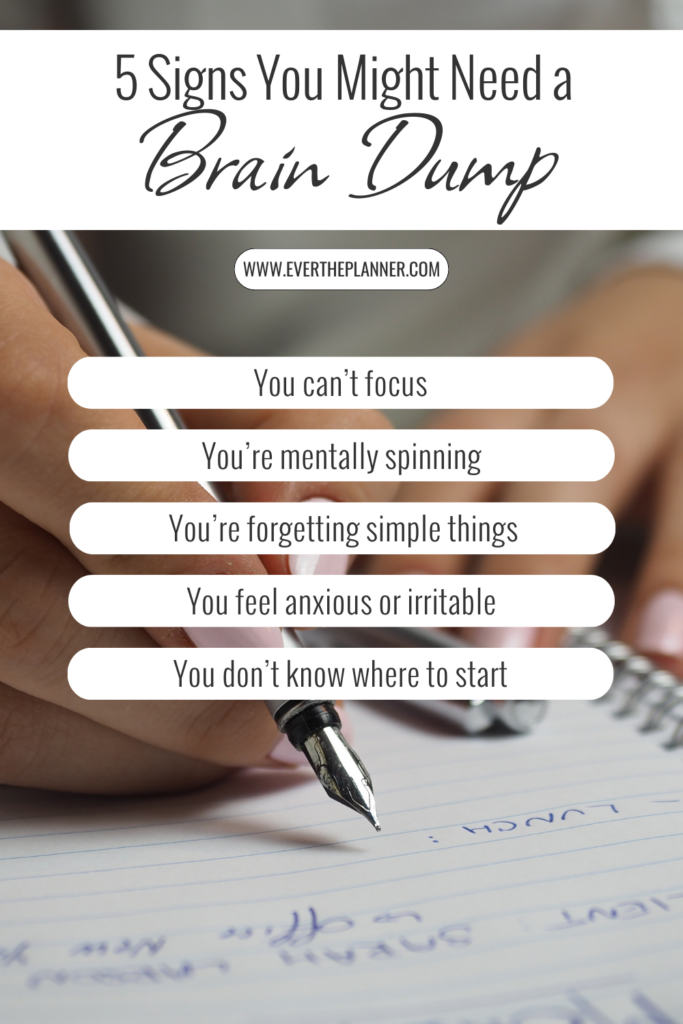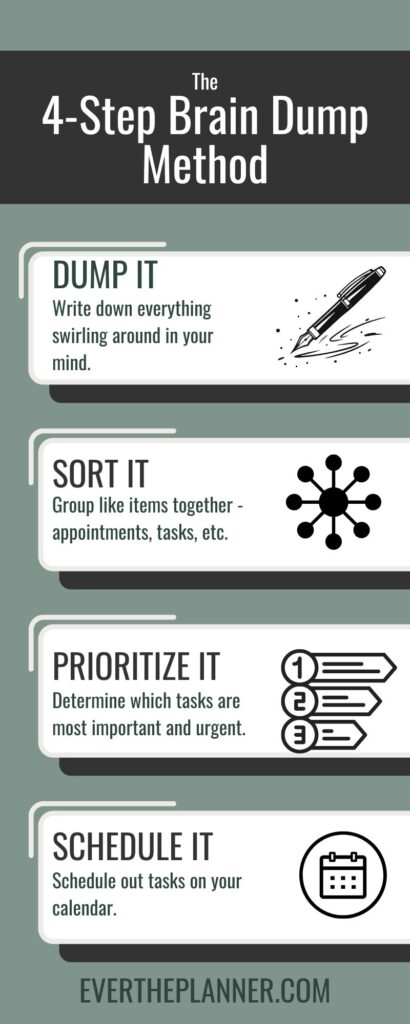The 4-Step Brain Dump Method That Will Boost Your Productivity

Feeling overwhelmed by everything in your head? Your mental to-do list just keeps growing—deadlines, grocery lists, ideas, appointments, things you should be doing, things you forgot to do. It’s exhausting. If you’ve ever sat down to work and just spun in circles, unable to focus, you’re not alone. That’s why I swear by the brain dump method—a simple, clear way to get all that mental clutter out of your head and onto paper.
A brain dump is one of my favorite go-to tools whenever I’m feeling stuck, scattered, or stretched thin. It helps me stop spinning and start sorting—so I can actually get things done.
In this post, I’ll walk you through the 4-step brain dump method I use to reset, refocus, and create a clear plan of action. Whether you’re navigating a full plate at work, home, or both, this process will help you breathe easier, think more clearly, and move forward with purpose.
TL;DR:
Learn how to use the 4-step brain dump method to clear mental clutter, reduce stress, and organize your ideas into actionable next steps.
Why the Brain Dump Method Works
Before we dive into the steps, let’s talk about why this method matters.
When your mind is holding onto everything—tasks, reminders, ideas, worries—it’s no wonder you feel scattered or stuck.
Things start to slip: appointments get missed, emails go unanswered, to-dos pile up, and suddenly even the smallest task feels overwhelming.
That constant mental juggling act? It’s exhausting.
The brain dump method gives your thoughts somewhere to go.
Instead of swirling around in your head, everything gets laid out in front of you—where you can actually do something about it.
It’s a powerful way to clear your mind and create space to think more clearly, calmly, and creatively.
When you make brain dumping a regular habit, you’ll notice:
- You feel more organized and in control
- You’re less stressed, anxious, or overwhelmed
- Your head feels clearer, like you finally have breathing room
- You’re more confident keeping up with deadlines and daily life
- You stop relying on memory and start trusting your system
- You reconnect with your goals—and take real steps toward them
- You’re more focused, more creative, and more productive
And here’s something I’ve learned: setting an intention before your brain dump can make a big difference. Ask yourself—what do I need from this moment?
- Mental clarity?
- Emotional release?
- A game plan for the week ahead?
Let that intention guide what comes out. There’s no right or wrong here—just a simple system to help you feel lighter, clearer, and more capable.

Step 1 – Dump it All Out (No Judgement)
Start by finding a quiet space—even just a few uninterrupted minutes can make a difference.
Grab a pen and some paper, or open a blank document, and let everything that’s floating around in your brain spill onto the page.
Don’t overthink it. Don’t filter it. And definitely don’t judge it.
This isn’t the time to organize or solve anything.
The goal right now is just to release.
You’ll sort through it later—right now, we’re just clearing the mental clutter.
Write down anything and everything that’s taking up space in your head.
It might be tasks or reminders, but it could also be worries, goals, or even grocery lists.
Here are a few things you might want to brain dump:
- Upcoming appointments and calls
- Emails you need to send or reply to
- Work tasks, projects, and deadlines
- Household chores or errands
- Groceries to pick up
- Kid or family schedules
- Things you’ve been avoiding
- Financial tasks or goals
- Creative ideas or dreams
- Random thoughts or feelings
- Emotional clutter or anxieties
- Things you “should” do but haven’t started
- Travel plans, packing lists, pet stuff—anything goes
If it’s in your head, it belongs on the page.
This is your space to be honest and unfiltered.
No one else is going to see this. You can organize it later—but for now, just let it out.
Step 2 – Sort it Into Categories
Now that everything’s out of your head and onto paper, it’s time to bring a little order to the chaos. This step is all about sorting your thoughts so they’re easier to understand and act on.
There’s no one “right” way to do this—so give yourself permission to find a method that feels natural to you. Here are a few ideas to get started:
- Color-code with highlighters
Use different colors for different categories to quickly spot themes. For example:- Yellow = Work
- Purple = Home
- Pink = Kids
- Green = Appointments & Calls
- Orange = Miscellaneous
- Rewrite onto a new sheet
If your brain dump is really messy (which is totally fine!), try copying your thoughts onto a new page and grouping them into categories like:- Personal
- Work
- Family
- Errands
- Goals
- “Later” list
- Use visual sorting cues
Circle related items. Draw stars around priority tasks. Use arrows to connect similar ideas. This is especially helpful if you’re more of a visual thinker and like to see how things relate.
The goal here isn’t to make it perfect—it’s to give your brain a sense of clarity and direction. Once you can see your thoughts in categories, it becomes so much easier to decide what comes next.
Step 3 – Prioritize What Really Matters
Now that your thoughts are sorted, it’s time to decide what really needs your attention—and what doesn’t.
This is where your brain dump turns into an actual plan.
Go through each category and ask yourself:
1. What needs to happen now—and what can wait?
Look at your list and separate tasks by urgency:
- What needs to be done today?
- What should happen this week?
- What can wait until later this month or even this year?
- Are there items that actually don’t need to happen at all?
It’s okay to let go of things that no longer serve you. Just because it was on your mind doesn’t mean it deserves your time.
2. What can be delegated or shared?
Not everything has to land on your shoulders.
Look for tasks that can be handed off to a partner, a coworker, your kids, or even a helpful tool or system.
Letting go of even a few small tasks can lighten your load more than you realize.
3. What has a deadline (real or self-imposed)?
Make sure you’re prioritizing based on time sensitivity.
Is there a due date? An upcoming event? A time-sensitive opportunity?
Mark those items clearly so they don’t sneak up on you.
Step 4 – Schedule What Needs to Happen
Now that you’ve prioritized your tasks, it’s time to take the final (and most important) step: schedule them.
Not just mentally.
Not “I’ll remember, or “I’ll do it later.”
Literally write them down.
Put them in your planner, your digital calendar, your Trello board—whatever system you use to manage your time.
This is how your brain dump turns into actual follow-through.
Start by scheduling your most urgent and important tasks—your today items.
Then plug in the rest based on their deadlines and priority:
- Tasks for tomorrow or this week
- Tasks to handle this month
- Long-term or end-of-year goals that need space on your calendar (even if just as a reminder)
It’s okay to start small. You don’t need to map out the entire year right now—but getting things out of your head and onto your calendar is how things actually start getting done.
Remember: if it’s not scheduled, it’s easy to forget. And if it’s written down, it’s real.
Let your calendar become your partner—not your pressure point.

Final Thoughts: Make Space to Breathe and Move Forward
A brain dump might seem simple, but don’t underestimate its power.
This 4-step method isn’t just about organization—it’s about clarity, peace of mind, and giving yourself a mental reset when everything feels like too much.
It’s a way to pause the overwhelm, sort through the noise, and move forward with purpose.
You don’t have to do it perfectly. You just have to start.
So the next time your thoughts are all over the place, sit down with a pen, give yourself permission to be honest, and let it all out.
Then take the next small step—and let that be enough for today.
Need help turning your brain dump into a content plan?
Grab my free Content Clarity Workbook—it’s filled with guided pages, brainstorming space, and simple planning templates to help you move from scattered to strategic, one step at a time.





Be the first to comment